Types of Wargame
In our WD Handbook we identify at least a dozen types of wargames, almost all of which WD members have played, and probably designed, over the years. This page gives a brief summary of the key types derived from our definitions in the Handbook, and lists them in increasing order of structure (essentially the extent - but not complexity - of written rules). As wargamers, playing (and designing) different types of games, even about the same battle or incident, can add considerably to the richness of the hobby, and for those only aware of wargaming as being about playing with toy soldier miniatures or pushing cardboard counters over large hex map it will hopefully show the broader range of the genre.
Note that categories are quite broad and ill-defined, and overlap, and many (small) wars have been fought over the definitions and attempts to order them by things like structured and unstructured!
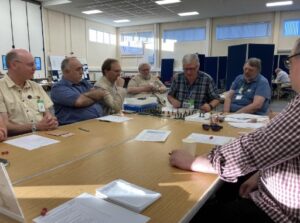 Committee Games
Committee Games
Committee Games are games in which the players decide on a course of action within a committee format. Usually the players are equal in game terms, although there may well be a chairman, who might be the person running the game. Normally associated with Hidden Briefings to each of the players, some (or all) of which may be mutually incompatible.
The organiser may, during the course of the game, present input in the form of events happening outside of the meeting (e.g. updates on the strength and location of the enemy) and at the end may assess the degree of success of the players in terms of their own objectives and the overall aim. If the aim was to plan a campaign it is, of course, not necessary to actually play this through; but equally it can form an interesting start to an otherwise conventional campaign. In summary the committee game is a perfect model of command friction, and as such can stand alone as a game or enhance a conventional game.
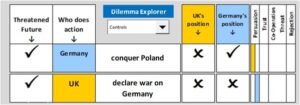 Confrontation Analysis
Confrontation Analysis
A Confrontation Analysis/Dilemma Analysis Game is a form of structured discussion game played with two to five teams of one to three people looking at a political or diplomatic confrontation. The players state what each team can do and what they want to have happen. The dispute can be described manually, using pens and paper, or with a spreadsheet program.
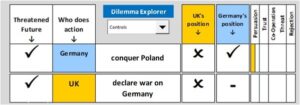 What happens during negotiations is that the options table changes. This can happen by:
What happens during negotiations is that the options table changes. This can happen by:
• people changing their positions (changing the ticks and crosses),
• by people introducing new options (new rows in the table),
• by one side expressing doubt - saying it does not believe the other party will do what it has threatened to do.
All of these actions are attempts to eliminate dilemmas. By structuring the negotiations in this way it is possible to track the progress of the negotiations and build up a history of the negotiations. Confrontation Analysis is a great way to structure, focus and plan negotiations, both in real life and in games.
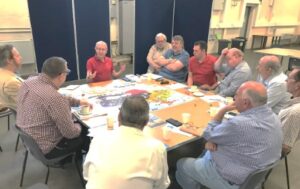 Matrix Games
Matrix Games
Matrix games were invented by Chris Engle, a psychologist, in the USA, in 1988. They were used recreationally by WD members and others, before being used professionally nearly 20 years later. In a Matrix game there are few pre-set rules limiting what players can do. Instead, each is free to suggest any plausible action or event during their turn. The chances of success or failure, as well as the effects of the action/event, are largely determined through structured argument and discussion. This process allows for imaginative game dynamics that are lively and open-ended, and yet also grounded in reality.
Matrix games are particularly well-suited for complex conflicts and issues involving multiple actors and stake-holders, varying interests and agendas, and a broad range of diplomatic/political, military, social, and economic dimensions. The game system crowdsources ideas and insight from participants, thereby fostering greater analytical understanding.
In a Matrix Game, you use words to describe why something should happen, the facilitator or the players (or both) decide how likely it is, and you might roll a dice to see if it happens (but equally, in the face of a compelling argument, you might not need to).
If you can say “This happens, for the following reasons...” you can play a Matrix Game.
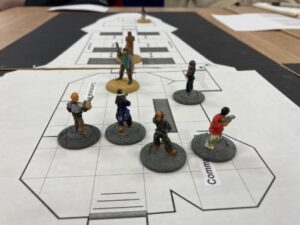 Role Playing Games
Role Playing Games
Role-Playing Games (RPG) normally refer to games in which the players represent specific individuals with assigned skills and abilities (often quite different from their real skills and abilities); all other elements of the game being represented by the Umpire. These are associated with some commercial fantasy and science-fiction games, such as Dungeons & Dragons and Traveller, in which each player usually controls only one “character”.
However, Role-Playing can also be used to mean that the players are invited to “act out” the personality assigned to them, for example if their assigned characters are cowards, they will “succeed” by running away at the crucial moment. Role-Playing games can be seen as a spectrum, with basic games requiring the players to play essentially their own character, but with game assigned strengths and weaknesses; through to more advanced Role-Playing games which require the players to act out of their individual characters and personalities, as well as giving them assigned strengths and weaknesses.
 Free and Rigid Kriegspiels
Free and Rigid Kriegspiels
In Free-Kriegsspiel two opposing courses of action are explained to an umpire who decides on which course will prevail, based on historical precedence, personal experience, reasoned debate and his or her own judgement. There are no rules to resolve battles, although there may be movement and deployment tables. So called because it was the method used in the later (post 1870) examples of the Kriegsspiel.
The original 19th Century military wargame was played as an “active umpire” game, with the blue and red players each in different rooms, and the umpire making decisions in a third. At first umpires used complex sets of rules to reach a verdict on what had happened (rigid kriegsspiels), but eventually it was found that this process was too laborious and time-consuming. The “free” wargame was preferred, whereby the outcome of actions was decided by the umpire, without rules, simply according to what he or she felt were the military probabilities of the situation.
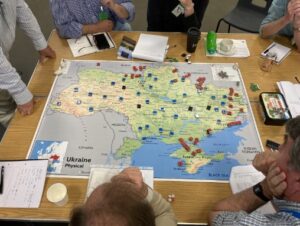 Map Games
Map Games
A Map Game is a game based on a map. This may be a real map of the terrain, dating from the period; or could be a sketch map representing only the important elements in the conflict to be examined. Some kriegsspiels were played using lead counters sized to represent unit formations, on an enlarged terrain map. Map Games are also played in a Back-to-Back game format.
The map game offers a number of attractive features for the wargamer. One, not inconsiderable, point in its favour is that of cost: for the price of two or three copies of a map (plus clear acetate covering and marker pens) it is possible to experiment with large scale operations without the expense of assembling costly model armies. Map games may use a variety of structured or unstructured approaches, and if overlayed with a grid or set of areas or nodes effectively become board games.
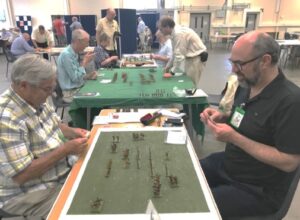 Miniatures Games
Miniatures Games
Miniatures games use 3D (or even 2D) models of soldiers, tanks, ships and aircraft to play out an encounter on a tabletop covered, where relevant, in 3D terrain (woods, buildings, rivers, hills etc). There is little hidden information (although blinds can be used), and casualties can be tracked by figure or base removal, loss markers, or tally keeping on stands or rostas. Whilst traditional "toy soldier" games rely on measuring distances for movement and firing a gridded table (in hexes or squares) is increasingly being used, blurring the line between miniatures games and board games.
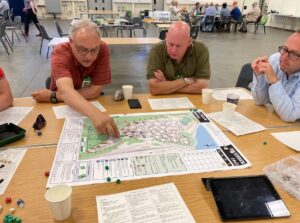 Board Games
Board Games
Board wargames have traditionally used small (< 1/2") counters to represent units, with the playing surface being a stylised map of the terrain overlaid with a hex or square grid to regulate movement and firing. The games can range from 1 or 2 man skirmishes to "monster games" representing the whole of the Eastern Front. In the past decade there has been an increase in the use of areas or nodes instead of regular grid to control movement and combat. There is also a blurring of board wargames and modern "board games", such as represented by the Euro and Ameritrash sub-genres. Given the regulation imposed by the game map these games typically have the most structured approach to rules and play - many of the larger rulesets reading like legal agreements.
This next pair represent styles of play which are becoming increasingly popular for game players and designers.
 Collaborative Games
Collaborative Games
Probably growing out of the the Role-Playing Game movement an increasing number of commercial games are of the "collaborative" variety, where all players are on the same side and trying to "defeat" the game in order to win. Unlike RPGs where the enemy is largely controlled by the GM in collaborative games the enemy is controlled by some form of algorithm, card deck or other "AI" and there is no need for a GM. Pandemic is probably the most well-known commercial collaborative game.
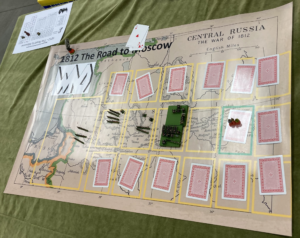 Solo Games
Solo Games
Almost any game can be played by one player as long as it doesn't include much hidden information and the player can be suitably schizophrenic about their play. However recent years have seen an increase in the number of games that either offer a "solo mode" with some form of "AI" to take on the role of the enemy/other player(s), or that are designed ONLY to be played by one player.
This final three are more about the environment in which the game is played.
 Manual Games
Manual Games
Manual games are those designed to be played without the need for a computer, i.e. just using a board or miniatures or even just discussion. They are the main thing that WD focusses on as almost anyone can design and build a manual wargame as it doesn't require any special skills in programming or computer modelling. Almost every game mentioned on this site is a manual game. Note though that if you play a manual game remotely using an -online tool such as Roll20, Tabletop Simulator or even Google Sheets or Excel it is still fundamentally a manual wargame as the computer is not essential to play.
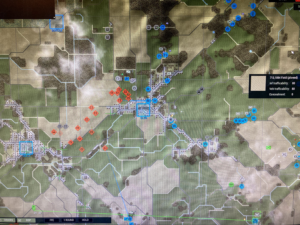 Computer Games
Computer Games
The opposite of manual games, computer games are those which NEED a computer to run. Just to confuse things some people term these "computerised" wargames - which seems a better definition for the manual-game-over-Roll20 approach. There is also a blurred area for games like Carnage and Glory which are computer-moderated system that take care of all the calculations and book-keeping in an otherwise manual game so that players can focus on the actual decision-making. As mentioned above computer games aren't (yet) a focus of WD.
 Lawn Games
Lawn Games
A WD speciality (and a key criteria for choosing COW locations), Lawn Game are - as the name implies - games requiring a lawn on which to play it. Implies a certain air of civilised gentility, as opposed to rampant competitiveness. Large scale models (1/32 or bigger, Action Men not unheard of), "cardboard" simulators and a variety of toy guns and other projectile throwers are typical ingredients - and sometimes the odd bit of ex-military kit.
Many other types of wargame are described in the WD Handbook, along with more information on many of the types described. Also check out past copies of The Nugget and previous Conferences for examples of the different forms.
